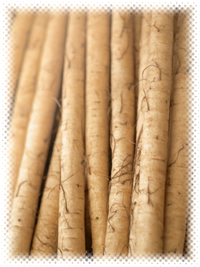Horseradish Armoracia rusticana

Horseradish roots
- Common Names
- Horseradish root
- Botanical Name
- Armoracia rusticana
- Syn. Cochlearia armoracia
- Family
- BRASSICACEAE
Medicinal Uses & Benefits of Horseradish Root
![]() How to Use|
Side Effects |
Plant & Garden|
How to Use|
Side Effects |
Plant & Garden|
- Medicinal Uses: * Athletes Foot/Ringworm
* Bladder Infection (UTI)
* Bronchitis
* Congestion
* Cough
* Gout
* Herpes/Cold Sores
* Scabies
- Properties: * Antibacterial * Antiscorbutic * Bitter * Circulation * Diaphoretic * Diuretic * Expectorant * Rubefacient * Stimulant
- Parts Used: grated root, seldom leaves
- Constituents: sinigrin (a glycoside which combined with water yields mustard oil), vitamin c, asparagine, resin
How to Use: Horseradish
Grated, fresh horseradish is pungent source of mustard oil and is used in herbal kitchen medicine in much the same way as mustard seed, as an excellent digestive stimulant for heavy, oily meats. Horseradish may be one of the fastest ways to clear congested sinuses, and its antibiotic properties helps to heal the root causes of infection as well. 1 If you are looking for an all purpose cold remedy, you may look no further than horseradish. Horseradish provides Vitamin C, promotes persipiration to "sweat it out", loosens both chest and sinus congestion, stimulates the nerves, and soothes a sore throat.5Horseradish is also a diuretic and useful for urinary infections. The depurative nature of horseradish may be why it is a longstanding folk remedy for gout and rheumatism 2Horseradish stimulates blood flow, increasing warmth and circulation to cold muscles and joints when used externally as a rubefacient in plasters and poultices.3,4
Preparation Methods & Dosage :Fresh grated root, combined with cider vinegar and honey. Use it externally as a poultice or plaster for rheumatic joints and to stimulate blood flow. One to two tablespoons of fresh grated root daily, 1/2 teaspoon tincture, or as horseradish dressing on foods. Grate it into a little lemon juice or vinegar.
Horseradish Remedies
 In the Kitchen: Horseradish or 'prepared horseradish' refers to the grated root of the horseradish plant mixed with vinegar. Prepared horseradish is white to creamy-beige in color. The young leaves can be lightly steamed and tossed with blander greens for a healthy meal.
In the Kitchen: Horseradish or 'prepared horseradish' refers to the grated root of the horseradish plant mixed with vinegar. Prepared horseradish is white to creamy-beige in color. The young leaves can be lightly steamed and tossed with blander greens for a healthy meal.
Horseradish Side Effects: Overuse may blister the skin. Do not use it if your thyroid function is low or if taking thyroxine.
Plant Description

Horseradish garden plants
- Plant Class: Perennial
- Flowers/Fruit/Seeds:The flowers from the stalk in panicles and are small and white.
- Parts used: Root, and leaves
- Leaves:A majority of the leaves rise directly from the top of the root on long, channeled leafstalks. The color is dark green, about a foot in length with wavy, toothed edges.
- Harvest Season:The roots can be dug any time of year the ground is not frozen. Gathered in autumn and stored in a cool celler, horesradish will keep until the next season.
- Distribution: Cultivated worldwide, perennial in hardiness zones 2�9. Horseradish needs a both a long growing season and winter temperatures cold enough to ensure plant dormancy
History and Traditions & Folklore
This plant has been in cultivation from the earliest times, but its exact place of origin seems to be obscure. Some consider it to be decended from Raphanos agros, or wild radish, by the anicient Greeks. It is said to be one of the five bitter herbs, the others are (coriander, coriander, lettuce, horehound, and nettle), to be eaten during Passover. 5Hooker considers that it is possibly a cultivated form of Cochlearia macrocarpa, a native of Hungary. 4 They are both under Mars. The juice of Horse-raddish given to drink, is held to be very effectual for the scurvy. It kills the worms in children, being drank, and also laid upon the belly. The root bruised and laid to the place grieved with the sciatica, joint-ache, or the hard swellings of the liver and spleen, doth wonderfully help them all. The distilled water of the herb and root is more familiar to be taken with a little sugar for all the purposes aforesaid.
They are both under Mars. The juice of Horse-raddish given to drink, is held to be very effectual for the scurvy. It kills the worms in children, being drank, and also laid upon the belly. The root bruised and laid to the place grieved with the sciatica, joint-ache, or the hard swellings of the liver and spleen, doth wonderfully help them all. The distilled water of the herb and root is more familiar to be taken with a little sugar for all the purposes aforesaid.
Nicholas Culpeper, 1653
- Duke,James, Ph.D. (2000). "The Green Pharmacy Herbal Handbook"
- Grieve, Maud Mrs. "A Modern Herbal" (1931)
- Mabey, Richard. "The New Age Herbalist",(1988)
- Hoffmann, David (2010-12-15). "Medical Herbalism: The Science and Practice of Herbal Medicine". Healing Arts Press.
- Euell Gibbons. "Stalking the Healthful Herbs", Alan Hood (1966), pg 14
Taken with oily fish or rich meat, either by itself or steeped in vinegar, or in a plain sauce, it acts as an excellent stimulant to the digestive organs, and as a spur to complete digestion. It is a very strong diuretic, and was employed by old herbalists in calculus and like affections. The root is expectorant, antiscorbutic, and if taken too freely, emetic. It contains so much sulphur that it is serviceable used externally as a rubefacient in chronic rheumatism and in paralytic complaints.










